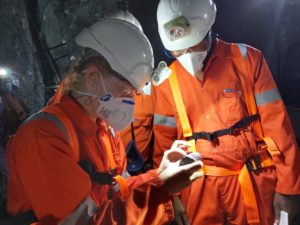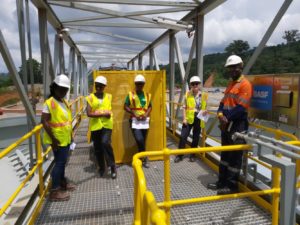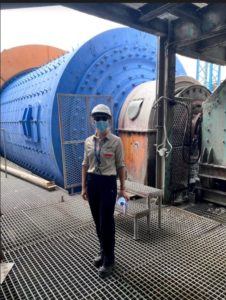London – 11 January 2021: Women in Mining UK 2020 Summer Internship at Golden Star Resources
Golden Star Resources Internship
During summer 2020 I was offered an internship at Golden Star Resources (Golden Star) in partnership with Women In Mining (WIM) UK. WIM partners with mining companies to provide opportunities to promote the employment, retention, and progress of women in the mining industry. Golden Star is an established mining company operating in West Africa, with one producing underground gold mine in Ghana. My internship was with the London head office Sustainability team. I’d like to thank WIM and Golden Star for this opportunity to learn new skills and to better understand the careers available in mining. The internship has been a fantastic experience and an affirmation of the improving cultures towards Women in mining.
My internship started in September 2020, during the COVID-19 pandemic. I was unsure how easy it would be to meet people and to get to grips with the differences between a universitybased PhD and a corporate environment. Whilst meeting a new team of people over Zoom was a little strange, the team at Golden Star felt connected, welcoming, and approachable, and perhaps that was due to the international nature of the business, rather than the necessary adaptation to Zoom meetings due to the pandemic.
The London team is relatively new, following the 2019 relocation from Toronto, and with a new strategy, there are plenty of opportunities. Being part of the corporate team, I had firsthand exposure to these strategic programs and learnt how that is translated into tactical implementation. I was able to sit in on many different meetings, from finance to operations to strategy, soaking up all the new information and learning how the different teams collaborate for business delivery. Through conversations with the Head of Sustainability I learnt about materiality assessments. A materiality assessment looks at key environmental, social, and governance (ESG) topics that are most important to a business and its shareholders. By defining material risks, companies can prioritise their efforts towards sustainability –economic, environment and social. One of the things I was keen to learn during the internship was about the interface between geology, science, and business. So, I found it interesting to learn about the technical projects to make a mine more sustainable. These are far reaching and cover aspects such as energy transition, water recycling, improving mining efficiency and design of closure plans for tailings storage facilities to enhance post-mining land use value.
Wassa, Ghana
I was fortunate enough to visit the mine site in Ghana for two weeks. The company’s focus on health, safety and wellbeing is impressive. The entire experience included yellow fever inoculation, thorough medical assessment and numerous COVID-19 screening protocols and testing. All in all a safe and efficient experience. After a COVID-19 test before flying and another at the well organised Accra airport, I was sure I did not have COVID! Ghana was warm and sunny (very different to London in October!) and I spent the first few days at our Accra office meeting the incredibly friendly corporate team. Not only did the Accra team take me to sample Ghanaian delicacies at lunch, but they also showed me around parts of the capital city, sharing valuable lessons on the history and culture of Ghana.
I was not sure what to expect on arrival at site, but it wasn’t what I imagined – there was a lot more infrastructure! Not only did the camp house a cafeteria and accommodation, but there was also a bar, tennis courts, and a swimming pool, all in a leafy green site. The Sustainability team, who I had met virtually on Zoom beforehand, looked after me on my visit and organised for me to meet many people around the mine site. The mine site was a short 10 minute drive from the camp, and again not as I imagined; a large complex of office buildings and machinery units surrounded the open pits and underground mine and the processing plant.
Over the two-week trip I was exposed to each stage of the mining operation. I saw drill rigs used for exploration, and in the core shed I was shown how to use a ‘rocket launcher’, a piece of kit used to correctly orientate drill cores and calculate the true dip and strike of lithological features. Wassa was originally mined as open pit mining before underground mine development, allowing me to investigate the geology in the open pit walls. I was taken on a geological tour by the pros, the Executive Vice President, Growth and Exploration and Vice President, Exploration, Peter and Mitch, who pointed out the gold pathfinders in the geological units. The geology at Wassa is intriguing with at least five deformation events resulting in some fascinating rocks! I had a further lesson with the Underground Geology Superintendent to understand how to plan where to mine underground and how to continue increasing geological confidence in the resource.
With my PhD in geochemistry, I particularly enjoyed visiting the processing plant and understanding each of the steps, from crushing and milling of the ore, to the carbon-in-leach and elution tanks for gold extraction. Whilst looking around the new paste-fill plant at the site, I learnt that fill is effectively cemented waste (rock and tailings) used to fill mined stopes. This allows the pillars between stopes to be mined, improving mining efficiency and gold recovery. The Wassa paste-fill plant is the first of its type in Ghana!
For my visit underground, I was suited and booted in a bright orange overalls, steel-capped gumboots, gloves, hearing protection, a hard hat, facemask, lights, safety glasses, and a heavy vehicle vibrating proximity alarm. I saw how the jumbo drill rigs are used to clean and drill the mining face, how the solo machines create blast holes, and how underground exploration drilling produces core for geological analysis and interpretation. The underground mine was bigger than I had expected, with long tunnels and openings including space for workshops underground!
Local Community Initiatives
During my site visit, I was also taken to local socio-economic initiatives that are supported by Golden Star. Golden Star has a subsidiary non-profit company called Golden Star Oil Palm Plantations (GSOPP). GSOPP is a social enterprise initiative that aims to reduce poverty by generating employment and local economic stimulus through sustainable agri-businesses. The palm oil sector has received a bad reputation in locations where deforestation and ecological damage precedes planting these cash crops, but in Ghana this is not the case and because oil palm is a native endemic species – Ghana hosts a large part of the West African oil palm belt. Not only is GSOPP deforestation free, but it provides alternative livelihoods to local communities, and additionally, oil palm plantations have been used by the company to sustainably revegetate Golden Star’s mine tailings facilities and other former mined lands, creating a high value post-mining land use.
I also visited local farmers and a community clinic that was setup with the support of Golden Star. Seeing first-hand the extent of the involvement and investment in community initiatives was beyond fantastic – to hear from farmers and nurses the impact these initiatives have on the quality of community lives is compelling. The clinic nurse explained to me how a program of training funded by Golden Star reduced the infant mortality rate for live births by a factor of 18, and one farmer proudly told me how he could now afford to send his oldest child to high school.
Project Work
I had three different projects during the internship which were initially office (or rather home!) based and then continued on site. These included an evaluation tool for use by GSOPP in siting future infrastructure, a position statement, and an analysis of water data management. These projects were completely different, teaching me about different aspects of the business and allowing me to meet more people.
One project involved the non-profit GSOPP. The strategic plans for GSOPP involve downstream processing for creation of a new revenue stream and enhanced sustainability. I was tasked with creating a tool to evaluate potential sites for this infrastructure.
Another project was on water data management. The project is part of a broader water stewardship plan for the mine site. To understand how data is collected on water, I needed to study the various flows, storage, and uses of water at the operation. I spoke with the surface mine manager about the importance of directing rainwater away from the underground mine, and with the senior electrical supervisor and pump attendants who ensure the pumps dewater the underground mine. The underground mine manager explained the design of the de-watering system and how it will be adapted as the mine develops. The metallurgical manager taught me about the use of water in the processing plant to extract gold from ore and explained that most of this water is recycled from the TSF. The tailings superintendent explained how the TSFs are built and how the water volume in the TSF is controlled. I spent time with the environmental team taking samples and measurements to test the quality of water around the site. I also learnt from the civil construction superintendent about the boreholes around site which provide potable water to the offices and accommodation.
Coming from a technical and detailed-orientated PhD in geochemistry and with limited background in mining, I wanted to do an internship to have an opportunity to see where my skills could fit in a mining company. Some of the projects were technical whilst others allowed me to learn about the broader sustainability issues that mining companies face. The role of sustainability in extractive The new pump station, part of the underground de-watering system. industries has never been so important. Whilst companies and countries are setting targets to reduce carbon emissions, investors expect commitments backed by science – meaningful strategies for business resilience and climate impact reduction. Companies are also being prompted to be more transparent and accountable for their biodiversity impact, water usage, recycling, social responsibility investment, local procurement, board diversity, and health and safety metrics, through adoption of various reporting standards. The range in projects that I was involved in gave me great exposure to all these issues.
Women In Mining
There is no question that there is still work to be done towards inclusion and diversity at all levels in the mining industry. However, the attitude I experienced at Golden Star was towards positive action; the women I encountered attributed their overall positive experiences to supportive and inclusive leaders. I was introduced to women at almost every stage of the production line, in the core lab, processing plant, at the rock face underground, in the sustainability team, the environmental monitoring team, in business improvement, and in the site offices. I was pleasantly surprised to find there were more women than I expected in the STEM roles. There is change happening in the mining industry, with companies like Golden Star actively creating opportunities to improve gender diversity by increasing the number of women in senior positions and bettering accessibility through collaborations with WIM. My advice to women finishing any stage of academia and considering a career in mining, is to go with your eyes and minds open and grab all the internship opportunities available.

